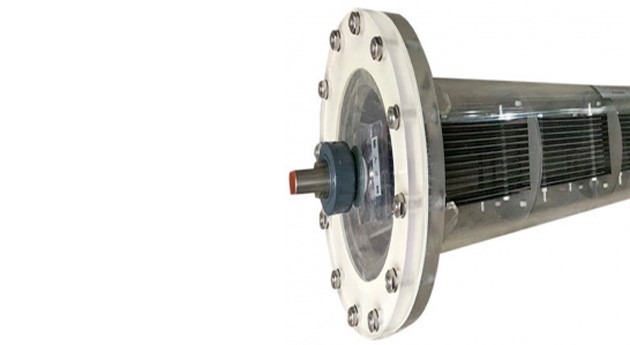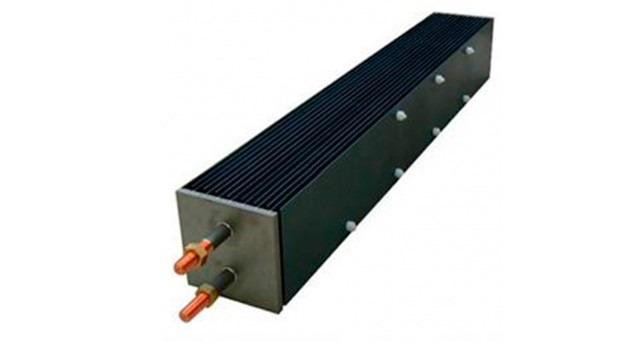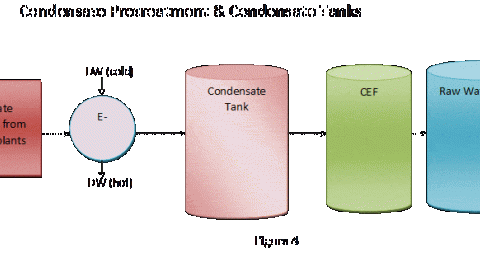Introduction
A seawater system in a utility plant is used to release heat by providing seawater through seawater heat exchangers. This system consists of a cooling tower, heat exchangers and pumps. The intake basin, where seawater is collected after cooling in the cooling tower, is pumped into the cooling heat exchangers. An electro-chlorination sodium hypochlorite dosing unit is used to dose sodium hypochlorite (NaOCl) solution into the cooling tower basin to control the growth of microorganisms. It was observed that the electrochlo-rination performance level decreased with an increased maintenance period and cost. It is recommended to switch to a new biocide generator technology.
1. The main parts of the cooling tower system:
The cooling water tower system consists of:
- A cooling tower where seawater is cooled by air blown by fans, and it is divided into eight sectors.
- The seawater makeup pumps can be used to provide a backup water supply in the firewater tanks.
- An intake basin, where seawater is collected after cooling in the cooling tower and then pumped to the cooling water heat exchangers. The intake basin is divided into four sectors.
- Heat exchangers where hot water from process plants is cooled by seawater.
- An electrochlorination unit for NaOCl solution generation and dosing.
2. Operation of the electro-chlorination unit and observation
The electro-chlorination unit uses electric power (DC) for electrodes to generate NaOCl. This overall chemical reaction can be expressed as follows: Salt + Water + Energy -> Sodium hypochlorite + Hydrogen:
NaCl + H2O + 2e ->NaClO+ H2
It was observed that during normal service of the sodium hypochlorite unit:
- The maximum achieved residual chlorine level decreased over time with continuous operation.
- Accumulation of hard scale inside storage vessels and lines transferring chemical solution to the cooling tower basin. This will require a longer time for cleaning and flushing.
- The electrochlorination unit is not reliable due to electrode failure with poor support from the vendor.
- Down time of the electrochlorination unit can last months.
- High risk of hydrogen gas generation and accumulation, therefore the unit requires ventilation and release.
Alternative Solution & Technology
Due to these observations on the existing system, another technology for dosing and controlling microorganism growth is the ClO2 dosing system.
3. ClO2Technology
The chlorine dioxide generator uses sodium chlorate (NaClO3),Hydrogen Peroxide (H2O2) and sulfuric acid (H2SO4) as precursors to produce chlorine dioxide (ClO2) on site. The ClO2 solution generated is easily piped to the point of application.ClO2 is an effective water biocide for applications in water treatment. As a dissolved gas, ClO2 controls microbial and algal bio-film. It is approximately 10times more soluble than chlorine.
ClO2 has bio-film penetrating properties; legionella is typically associated with bio-films.
ClO2 is the safest and most cost-effective chlorine dioxide technology. ClO2 neither reacts nor hydrolyzes, nor degrades in water. ClO2 is therefore not affected by the pH of the water, making it a very efficient biocide over a wide range of pH values.
Advantages of ClO2
- Wide pH range 4-10
- Penetrates biofilms (kills bacteria inside biofilm)
- Effective on bacteria, fungi and algae
- Very fast acting and breaks down rapidly
- Nonreactive to most organics (process leaks)
- High quality and safe equipment with multiple controlled injection points possible
- Strong and fast kill effectiveness—microbes do not develop immunity to ClO2.
- Eliminates generated hydrogen risk.
Generation of Chlorine dioxide
A chlorine dioxide generator produces a safe concentration of ClO2 in an aqueous solution from three chemicals (NaClO3, H2O2 and H2SO4).Typical H2SO4 volume is 70 % of total reactants volume.
NaClO3 + ½H2O2 + ½ H2SO4 ---> ClO2 + ½ NaSO4 + ½O2 + H2O








